
Cracking
Shingles are going to have to be replaced if there is cracking going on. The scope of the replacement depends upon how soon the issue is caught, so vigilance remains important. Find out more about a leaky roof and what to do.
Photo: Courtesy of Structure Tech

Wind Damage
The trouble with a wind damaged roof is that the exposed spots on the roof can be difficult to detect, especially if the shingles have been lifted. A shingle that has been lifted due to winds may have loosened the sealant and possibly the nail, all of which means replacing the roof. Learn these tips for shingle removal so you don’t have a bed of nails on your ground.

Exposed Nails
Exposed nails can rust and lead to a leaky roof. Depending upon how many nails are exposed and how long they’ve been exposed it may call for a roof replacement. Several factors determine the cost of roof replacement.
Photo: Courtesy of Structure Tech

Granules Missing
Roofs will lose granules through the course of time, so whether you need a completely new roof depends on the age of your roof and how many granules remain.

Curling
Seeing curling shingles can mean a sign of bigger issues, like leaking, which can mean a roof replacement. Shingles can curl because they weren’t lined up properly, they’re old, they weren’t installed correctly, you have poor ventilation in the attic or you’ve got a layered roof. If you see curls, it’s best to have it get checked out sooner than later.
Photo: Courtesy of Structure Tech

Leakage
If you’ve got a leaking roof, there’s no time to waste to get it fixed. A leaky roof can lead to structural damage.

Roof Cement
Metal flashing prevents leaks where shingles meet other surfaces, like walls and chimneys. Proper flashing work takes time and know-how, so sloppy roofers sometimes slather on roof cement instead. It seals out water long enough for them to cash your check, but it soon hardens, cracks and leaks. In the end, all it does is make a proper repair more difficult. So if you see heavy “tar” patchwork on your roof, fix it right—before it leaks and leads to interior damage, but hold off on replacing the entire roof.

No Chimney Cricket
A wide chimney forms a dam on your roof. Debris builds up behind that dam and holds moisture, which leads to rusted flashing and wood rot. Any chimney wider than 30 in. needs a “cricket,” or “saddle” basically a small roof built behind the chimney. A properly installed chimney cricket will direct water and debris around the chimney and off the roof. If your chimney doesn’t have one, watch for holes rusting through the flashing. If you’re getting a new roof, be sure the contractor’s bid includes a cricket but don’t rush to replace a roof if there’s no signs of issues.

Missing Kick-Out Flashing
Kick-out flashing is critical where a roof edge meets a sidewall. Without it, roof runoff flows down the wall and possibly into the wall. This is worst when there is a door or a window below and water can seep behind the trim. You might not notice it for years, but eventually rot will destroy sheathing and framing. In extreme cases, the stucco is the only thing holding up the wall! Don’t wait for that to happen to you, it doesn’t necessarily mean replacing a roof but you’ll have to fix it. To see how to add kick-out flashing, read Use a Kick-Out Flashing to Stop Rot.
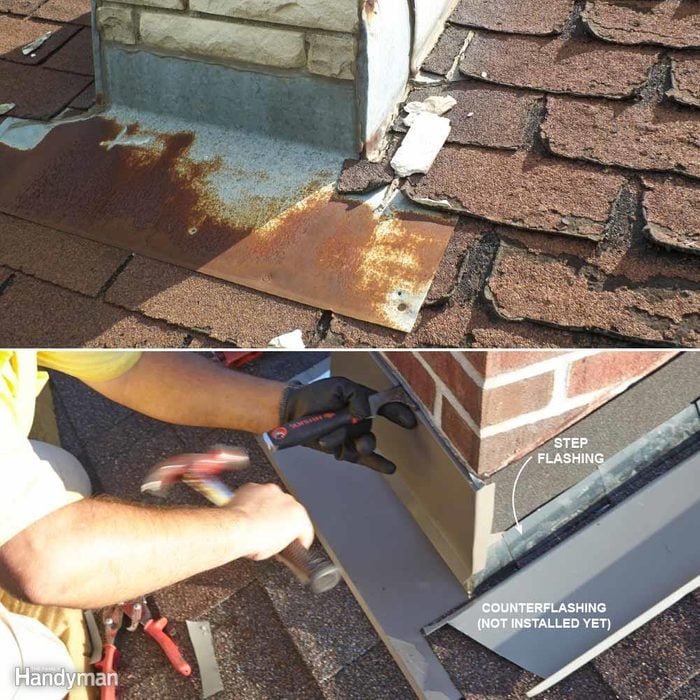
Bad Chimney Flashing
Good chimney flashing includes sections of “step flashing” that run up the sides of the chimney, and “counterflashing.” Counterflashing fits into grooves cut into the chimney and covers the step flashing. Cutting, fitting and installing all those parts takes time, so sloppy roofers take shortcuts.
Improperly flashed chimneys (top photo) cause lots of rotting roof sheathing and framing members. Chimneys need to be properly step-flashed and counterflashed so that water can't run down the face of the chimney and into the attic. You can't rely on caulk or roof cement to keep water out. If you suspect your flashing is shoddy, crawl into the attic after a heavy rain. Look for signs of water around the chimney and downhill from it.

Missing Gutter Apron
When water flows off the edge of your roof, some of it clings to the underside of the shingles and dribbles toward the fascia. If you have gutters but no gutter apron to stop the water, it will wick behind the gutter. Eventually the fascia, soffits and even the roof sheathing will rot. You may see water stains below the gutter on the fascia and soffit. This is a sure sign that the gutter apron is missing. Though you may not need a new roof immediately, you might have to replace it eventually.
The best time to add gutter apron is when you’re getting new shingles. But it is possible to slip gutter apron under existing shingles. A dab of roof cement every couple feet will “glue” it to the shingles and hold it in place. You’ll have to remove gutter brackets or straps and then refasten them after the apron is in place. Gutter apron is available at home centers in 10 ft. lengths.
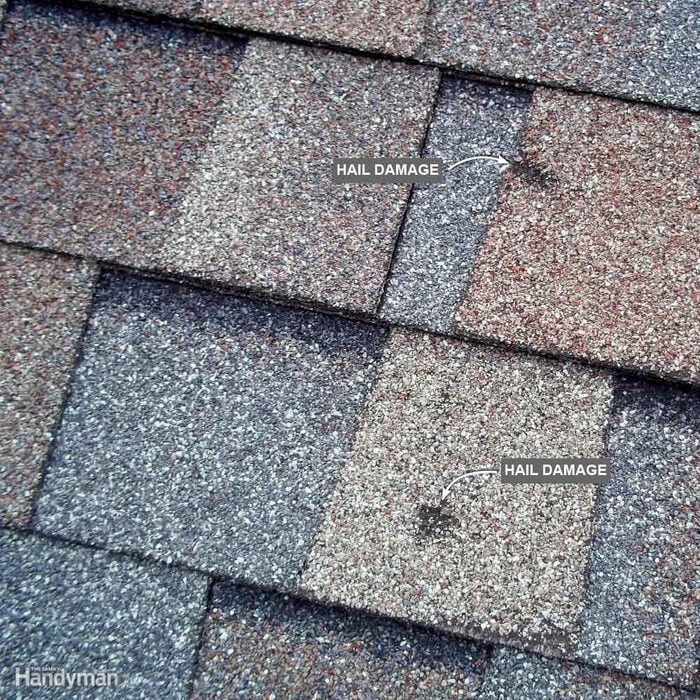
Hail Damage
When a large hailstone hits an asphalt shingle, it can tear or even puncture the shingle. But usually, it just knocks granules off the surface. When a shingle loses its protective layer of granules, UV rays from the sun begin to destroy it. More granules fall off around the damaged spot and the bruise grows. The damage may not be obvious at first, so if you suspect hail damage, get an inspection from a roofing contractor. Most offer free hail damage inspections.
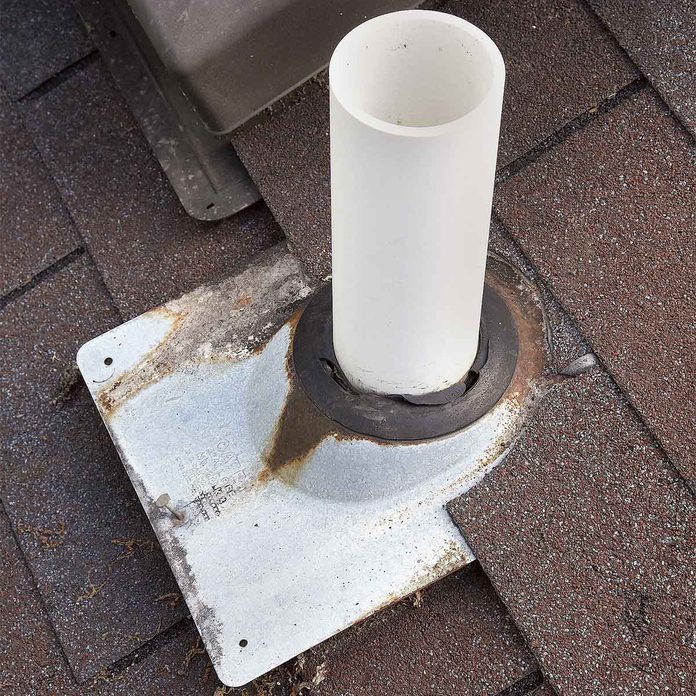
Damaged Plumbing Vent Boots
Plumbing vent boots can be all plastic, plastic and metal, or even two-piece metal units. Check plastic bases for cracks and metal bases for broken seams. Then examine the rubber boot surrounding the pipe. That can be rotted away or torn, allowing water to work its way into the house along the pipe. With any of these problems, you should buy a new vent boot to replace the old one. Replacing the boot will solve the problem and most likely not mean a complete roof replacement. But if the nails at the base are missing or pulled free and the boot is in good shape, replace them with the rubber-washered screws used for metal roofing systems. Learn more about replacing plumbing vent boots here.
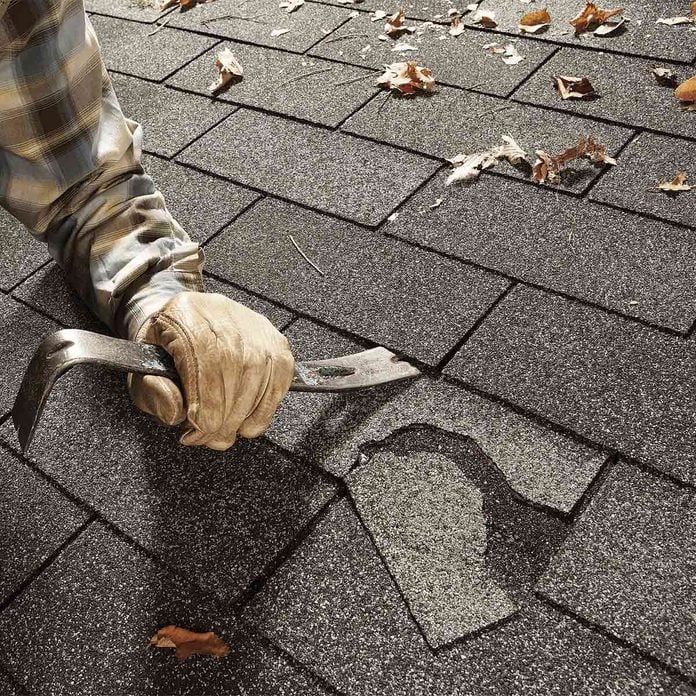
Damaged Shingles
A broken shingle is both ugly and a leak waiting to happen. But as long as you can find matching shingles (and you’re not afraid of heights), the repair is straightforward. Here’s how to do it. Depending on the damage you may or may not replace your roof.

Roof Vent Issues
Check for cracked housings on plastic roof vents and broken seams on metal ones. You might be tempted to throw caulk at the problem, but that solution won’t last long. There’s really no fix other than replacing the damaged vents. Also look for pulled or missing nails at the base’s bottom edge. Replace them with rubber-washered screws. In most cases, you can remove nails under the shingles on both sides of the vent to pull it free. There will be nails across the top of the vent too. Usually you can also work those loose without removing shingles, so you don’t necessarily have to replace the roof. Screw the bottom in place with rubber-washered screws. Squeeze out a bead of caulk beneath the shingles on both sides of the vent to hold the shingles down and to add a water barrier. That’s much easier than renailing the shingles. Plus: Turbine vents vs. flat roof vents.
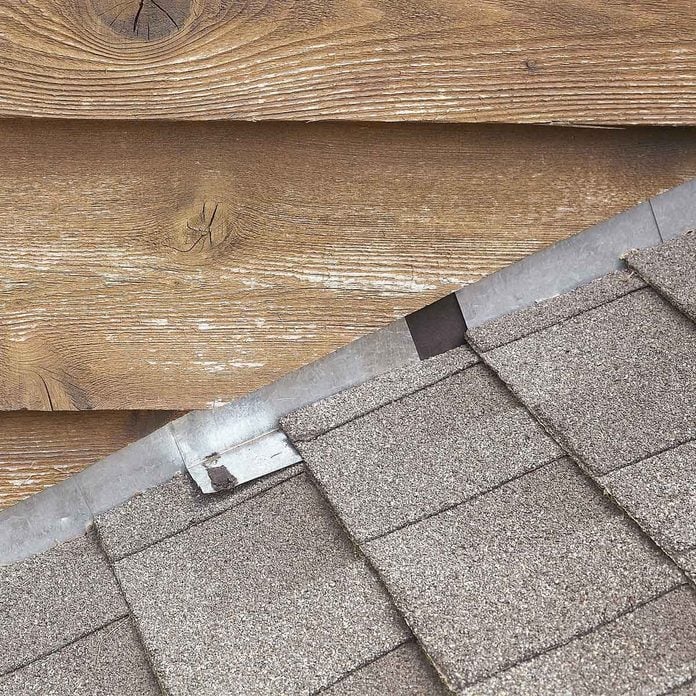
Loose Step Flashing
Step flashing is used along walls that intersect the roof. Each short section of flashing channels water over the shingle downhill from it. But if the flashing rusts through, or a piece comes loose, water will run right behind it, and into the house it goes. It might not mean a whole roof replacement but the situation needs fixing. Learn how to install step flashing here.
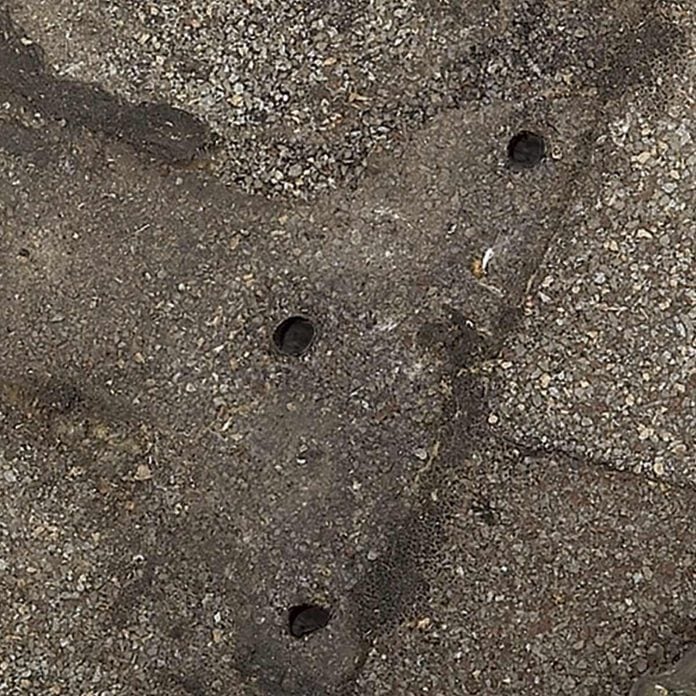
Holes Drilled on Purpose
Tiny holes in shingles are sneaky because they can cause rot and other damage for years before you notice the obvious signs of a leak. You might find holes left over from satellite dish or antenna mounting brackets or just about anything. And exposed, misplaced roofing nails should be pulled and the holes patched. Small holes are simple to fix, but the fix isn’t to inject caulk in the hole. You’ll fix this one with flashing and spot replace the roof.
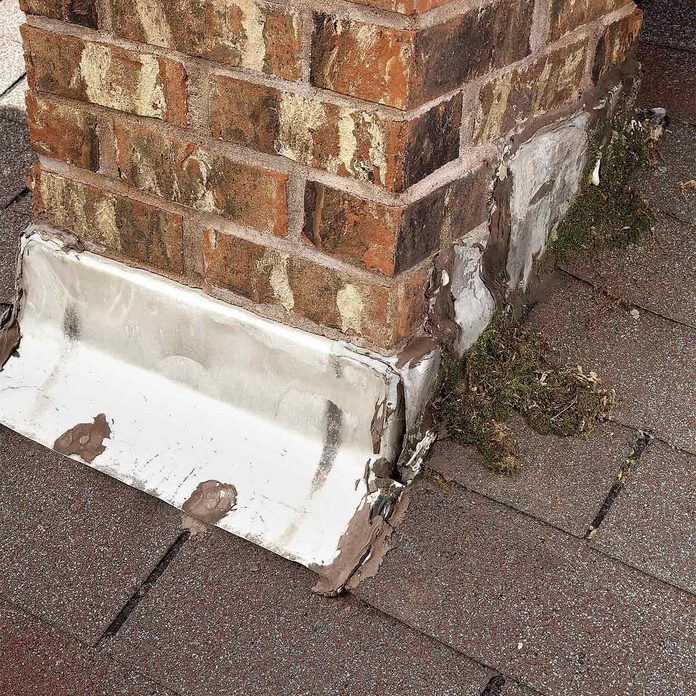
Rusted Chimney Flashing
All kinds of bad things can happen around brick chimneys. Flashing around chimneys can rust through if it’s galvanized steel, especially at the 90-degree bend at the bottom. A quick but fairly long-term fix is to simply slip new flashing under the old rusted stuff. That way any water that seeps through will be diverted. Learn about proper chimney maintenance here. (Replace all around chimney)

Fix Walls and Dormers
Water doesn’t always come in at the shingled surface. Often, wind-driven rain comes in from above the roof, especially around windows, between corner boards and siding, and through cracks and knotholes in siding. Dormer walls provide lots of spots where water can dribble down and enter the roof. Caulk can be old, cracked or even missing between the corner boards and between window edges and siding. Water penetrates these cracks and works its way behind the flashing and into the house. Even caulk that looks intact may not be sealing against the adjoining surfaces. Dig around with a putty knife to see if the area is sealed. Dig out any suspect caulk and replace it with a siliconized latex caulk. Also check the siding above the step flashing. Replace any cracked, rotted or missing siding, making sure the new piece overlaps the step flashing by at least 2 in. If you still have a leak, pull the corner boards free and check the overlapping flashing at the corner. Often, there’s old, hardened caulk where the two pieces overlap at the inside corner but this roof fix doesn’t mean a complete roof replacement, maybe a spot fix at best.

Complex Roof Problem
This roof leaks during the snowy part of winter and during storms in the summer, certainly due to poor flashing. The soffit that meets the roof is one of the toughest areas to waterproof. In the photo, you can still see signs of an ice dam. An ice dam occurs when snow melts and the water freezes when it hits the colder edges of your roof. Eventually, water pools behind the dam and works its way back up under the shingles and under the soffit until it finds an opening through the roof.
The solution begins with good flashing, since this should stop leaks from rainfall and might stop the leaks from ice dams as well. Begin by removing the shingles down to the wood sheathing and slip a strip of adhesive ice-and-water barrier (available where roofing products are sold) under the soffit/main roof joint. Depending on how the roofs join, you may have to cut a slot to work it in far enough. It should overlap another piece of ice-and-water barrier laid below, all the way down to the roof edge. This should cover the most leak-prone areas. Then reshingle, sliding metal step flashing behind the fascia board (the trim behind the gutter). The valley flashing, laid over the joint where the two roofs meet, should overlap the step flashing at least 2 in.
If leaks continue to occur from ice dams, consider installing roof edge heating cables. (Find them locally at hardware stores or home centers.) Improved attic insulation and ventilation are usually the best ways to prevent ice dams, but they might not be effective in this complicated roof situation.

What makes the streaks?
The black streaks running down roofs are actually a hardy algae called Gloeocapsa magma. As the blue-green algae accumulate, they develop a dark, hardened outer coating, which results in the black stains you see. The algae feed on the limestone in shingles.
The algae will worsen and become more noticeable each year, trapping moisture and causing premature shingle aging and granule loss. If you don’t like the streaks, reshingle with algae-resistant shingles. If the streaks don’t bother you or you’re not ready to invest in a new roof, install zinc or copper strips (available at roofing centers) along the top course of shingles. When rain hits the strips, it produces a solution that runs down the roof and keeps algae, moss and fungus from growing. However, the strips won’t eliminate the existing algae. Learn how to clean roof stains yourself here.